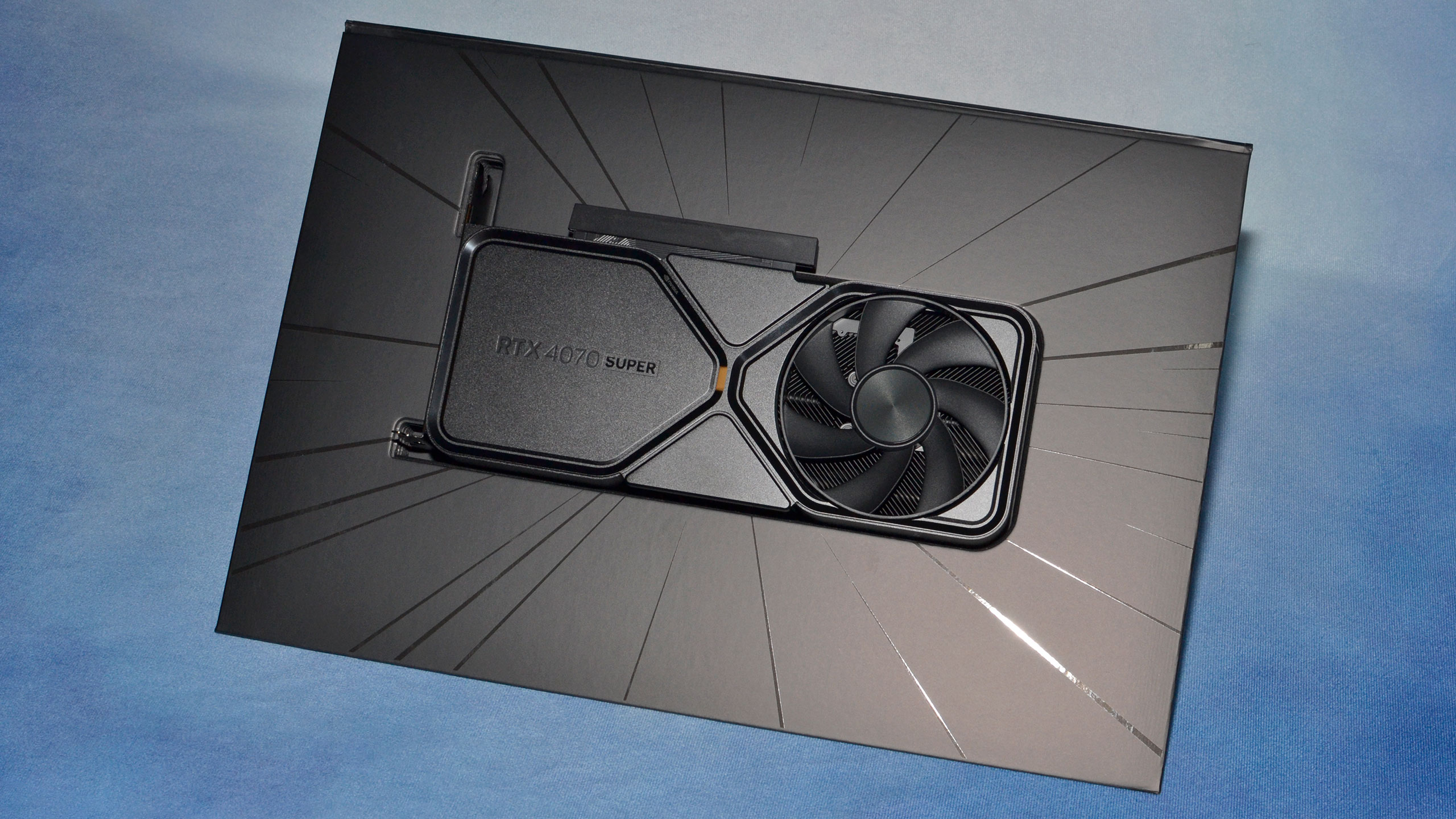Why you can trust Tom's Hardware
Nvidia RTX 4070 Super AI Performance
GPUs are also used with professional applications, AI training and inferencing, and more. Along with our usual professional tests, we've added Stable Diffusion benchmarks on the various GPUs. AI is a fast-moving sector, and it seems like 95% or more of the publicly available projects are designed for Nvidia GPUs. Those Tensor cores aren't just for DLSS, in other words. Intel has XMX (Xe Matrix eXtensions) for a similar performance boost, while AMD has "AI Accelerators" in RDNA 3 to help boost FP16 performance. Let's start with our AI testing and then hit the professional apps.
We're using Automatic1111's Stable Diffusion version for the Nvidia cards, with the TensorRT extensions enabled. Intel has an OpenVINO fork of Automatic1111's repository, which shows about a 50% improvement over our previous testing. Finally, AMD has a DirectML fork of Automatic1111, though there are some limitations. Specifically, the DirectML fork seems tuned specifically for RDNA 3 GPUs. In theory, it should also work with RDNA 2, Intel, and Nvidia GPUs, but performance tends to be far worse (RDNA 2), or else it doesn't work at all (last time we tried Intel and Nvidia GPUs).


As we saw with the gaming results, the 4070 Super lands right between the 4070 and 4070 Ti. This time it's closer to splitting the difference, with 12% more performance than the 4070 and 11% less performance than the 4070 Ti — that's at 512x512. For 768x768, it's 11% faster and 10% slower to those same GPUs.
AMD's GPUs can in theory run larger LLMs as they have more VRAM, but Nvidia offers far more AI compute performance than AMD. The 4070 Super is 40% and 30% faster at 512x512 and 768x768, when compared with AMD's current top GPU, the 7900 XTX.
Nvidia RTX 4070 Super Professional Workloads
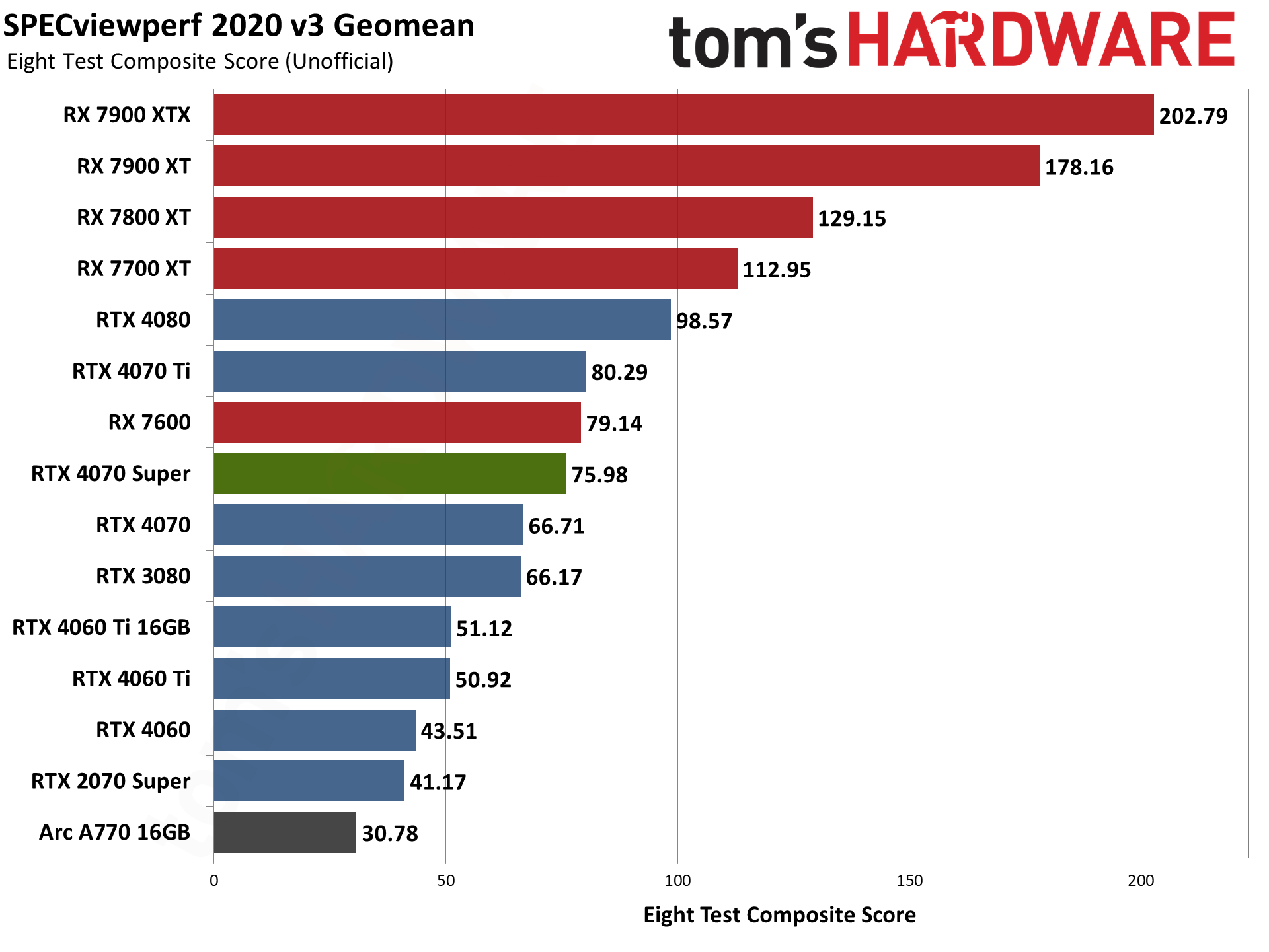
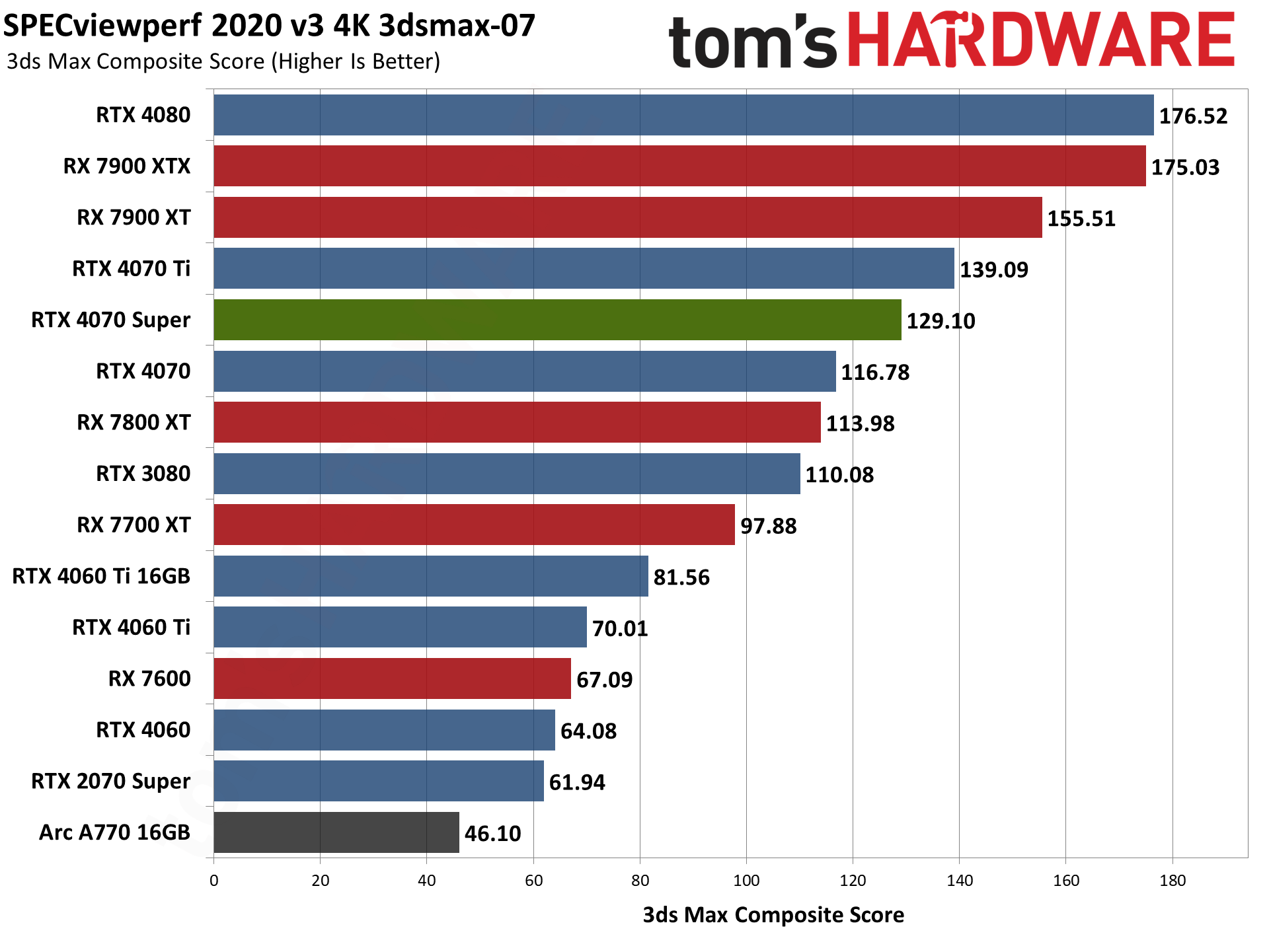







We use SPECviewperf 2020 v3 to assess professional workstation graphics performance on the various GPUs. Nvidia only offers full performance tuning in its drivers for professional GPUs like the RTX 4500 Ada Generation (which also uses AD104 silicon), while AMD tends to be more forthcoming with driver tuning for its consumer cards.
As a result, in the overall view of performance using the geometric mean of all eight tests, the 4070 Super only manages to match the RX 7600, and falls far behind the 7900 XT. Nvidia would point users interested in better performance — particularly in the Medical and SNX workflows — to its workstation offerings, but of course the RTX 4500 Ada costs over three times as much as the 4070 Super.




For GPU-accelerated 3D rendering, the only app that currently supports all three GPU vendors is Blender. It now leverages the ray tracing hardware to boost performance, and that generally puts Nvidia in the pole position. We're using Blender Benchmark, version 3.6.0, though version 4.0.0 is also available. We've found some GPUs, including all of the Nvidia models, perform better with version 3.6.0, and it's not clear whether 4.0.0 executes the same workload or if it does extra calculations to deliver a better result.
Given the use of ray tracing hardware, it's no surprise that Nvidia's GPUs come out far ahead of AMD's offerings. This is basically like the path tracing games results, and the 4070 Super is 84% faster than AMD's 7900 XTX.

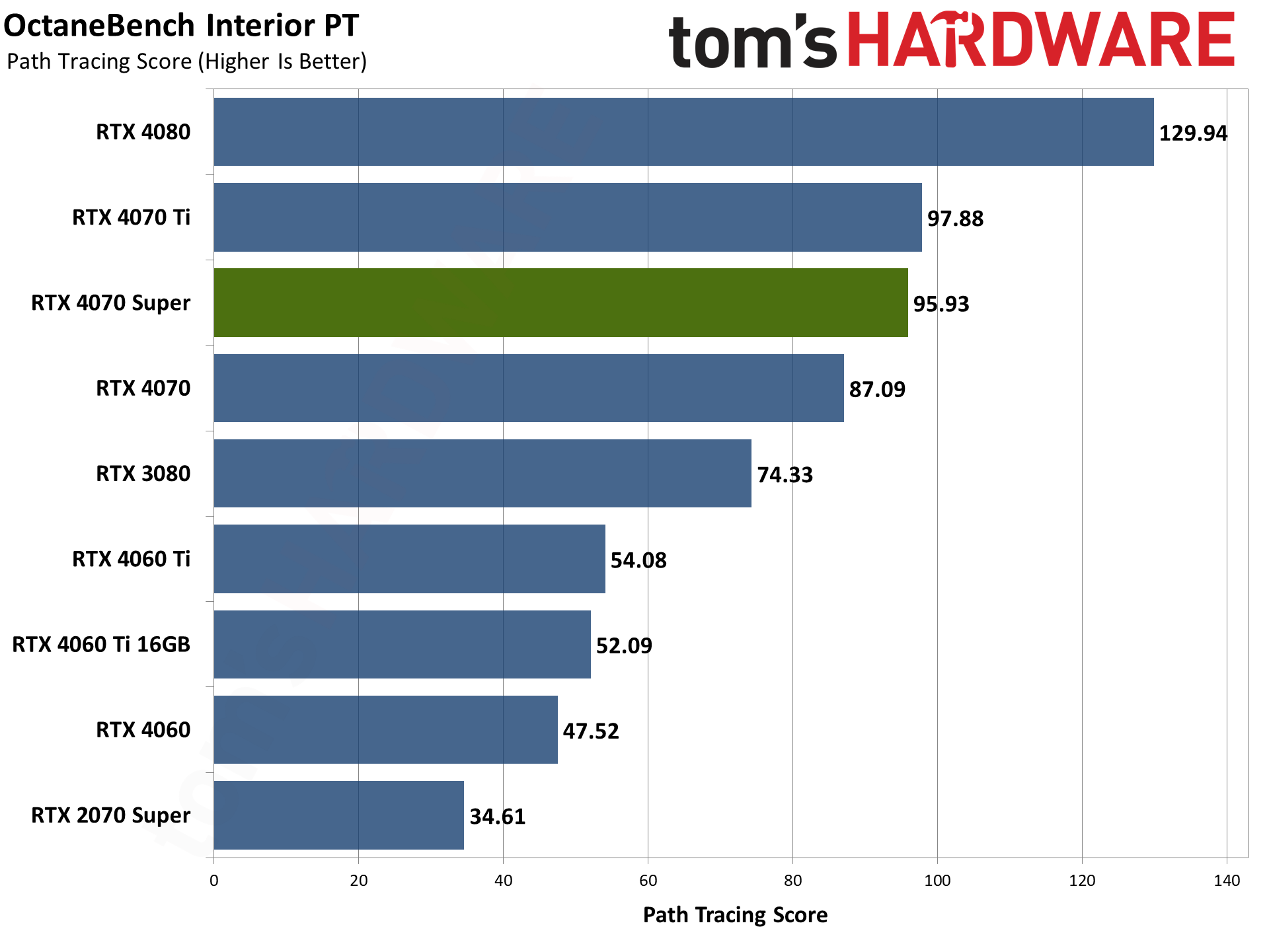

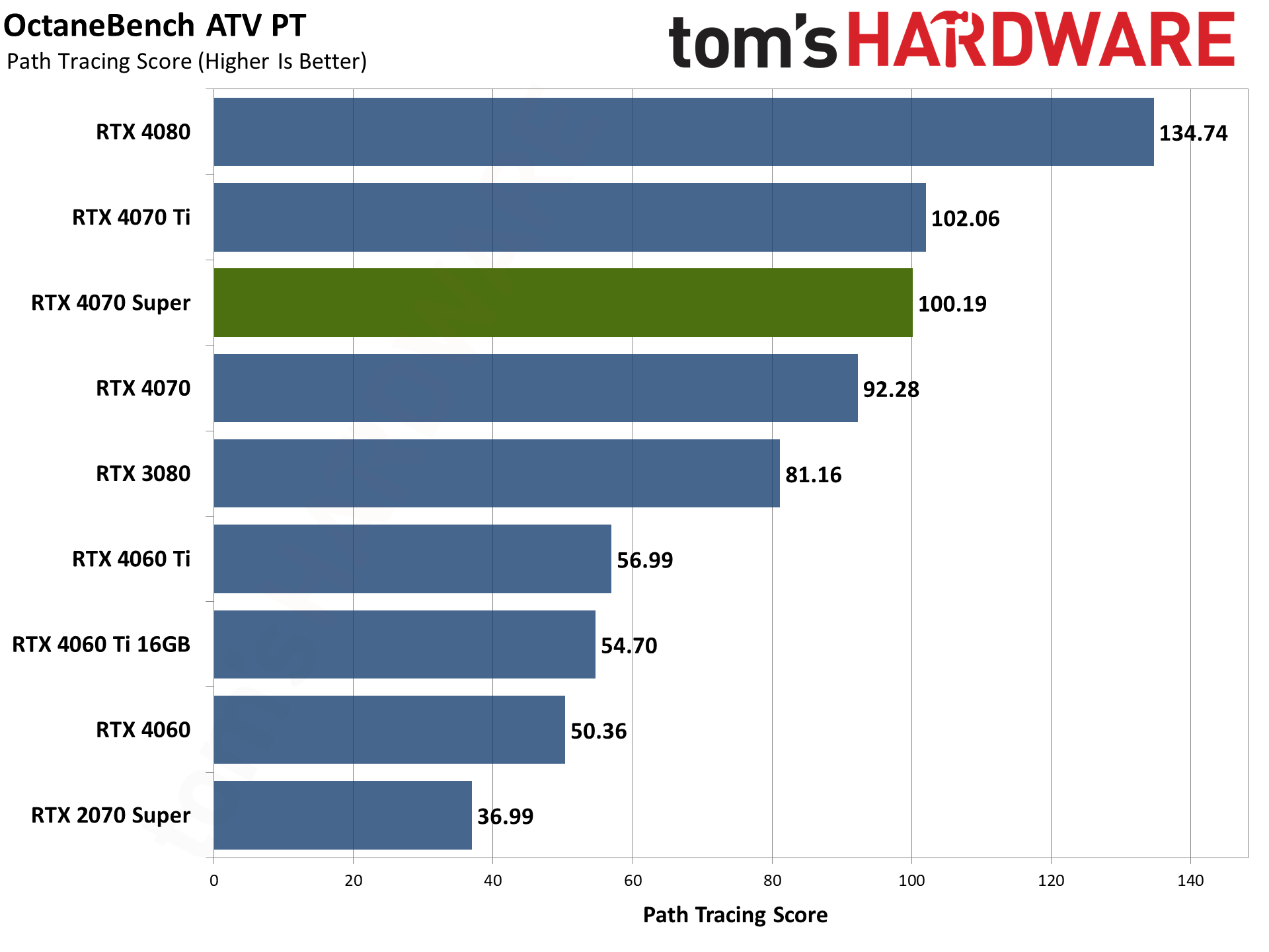



Nvidia also has RT hardware acceleration for Otoy OctaneRender and V-Ray, but the other GPU vendors currently lack hardware acceleration for these benchmarks. As such, we once again see the 4070 Super landing between the 4070 and 4070 Ti, but closer to the Ti in overall ray tracing performance.
Nvidia RTX 4070 Super Content Creation Summary
Professional workloads running on a consumer GPU are a bit of a wild card situation. Certain applications do really well — like ray tracing and AI — while others end up with limited driver tuning. AMD loses in the RT and AI results but wins in the SPECviewperf results, while the reverse is true of the Nvidia 4070 Super.
If you're more of a hobbyist trying to learn how to use some of these professional applications, it's possible to get started using consumer hardware. Once you become a working professional doing CAD/CAM or other work, however, the cost of the GPU hardware often becomes far less of a concern. Most companies working in these industries provide the necessary hardware, with the higher cost being far outweighed by the increase in productivity and throughput.
Get Tom's Hardware's best news and in-depth reviews, straight to your inbox.
- MORE: Best Graphics Cards
- MORE: GPU Benchmarks and Hierarchy
- MORE: All Graphics Content
Current page: Nvidia RTX 4070 Super: Professional Content Creation and AI Performance
Prev Page Nvidia RTX 4070 Super: 4K Gaming Performance Next Page Nvidia RTX 4070 Super: Power, Clocks, Temps, and Noise
Jarred Walton is a senior editor at Tom's Hardware focusing on everything GPU. He has been working as a tech journalist since 2004, writing for AnandTech, Maximum PC, and PC Gamer. From the first S3 Virge '3D decelerators' to today's GPUs, Jarred keeps up with all the latest graphics trends and is the one to ask about game performance.
-
Gururu So they squeeze out a few more FPS to beat the 7800xt and charge $50 more. The price games are maddening.Reply -
AgentBirdnest Mostly what I was expecting... but wow, those results against the 7800XT at 1440p are kinda crazy. +24% for the whole suite, and about +50% in the RT-only results? AMD really needs to rethink the price of the 7800XT.Reply
Interesting results, and interesting article (so far. I look forward to the rest. Hope you get some good sleep until then, Jarred. :))
I'm curious to know how well it overclocks. Can it match the 4070 Ti? -
atomicWAR While a step in the right direction, the ram capacity is still really underwhelming but the performance is promising. The 4070 series (Ti, super or otherwise) should have come with 16GB while the 4080 series should have had 20GB...This gen, save the 4090, has been really disappointing. Cost increases (70/80 series) with underwhelming performance (60/70/80) have been fairly pervasive in the product stack. I hope this helps things...I am interested in the 4070 Ti Super as many of my nephews and nieces have been wanting to upgrade this gen and thus far it has been hard to recommend anything other than the 4090 to them which is out of their budgets by about 700 dollars give or take a hundred.Reply -
Tom Sunday Reply
12GB of 4070 SUPER bliss? That is the million dollar question? At this point in time I would expect more than 12GB of VRAM in especially 2024. Even a 1080ti already had 11GB of VRAM in its side pocket. Will it pay in holding-out for a 4070 Ti SUPER: 2.5X Faster than the RTX 3070 Ti and sporting a mouth watering 16GB of GDDR6X? With that along bolstering CUDA cores, VRAM and reaching 4K gaming heaven? Will in fact a 4070 Ti SUPER be essentially a slight cutdown of the original RTX 4080, meaning that one can expect to see similar performance from the two cards?Gururu said:So they squeeze out a few more FPS to beat the 7800xt and charge $50 more. The price games are maddening.
Overall and in my very limited view the ‘4070 Super Refresh’ series is indeed a welcomed addition. It's commendable that the Super’s overall offer much better ray tracing performance, better energy efficiency and generally a notable performance upgrade compared to the Non-Super cards. No question that NVIDIAs latest 'Super-Play' will certainly put AMD under greater pressure, because they offer more performance and efficiency for basically the same price points. On the flipside I understand that the 4070 Super Refreshes do give the impression that they are only a mid-cycle gap filler. Because of the price? Further if AMD would only lower the price of the 7800XT, many I think would still go for the XT. In some instances AMD reputably has long preferred to stake a few cards at higher prices than to gain market share through price reductions. Food for thought! -
pocketdrummer Toms Hardware needs to do a price to generation performance uplift chart. Use performance uplift as the tier and not the actual product names (xx70 and xx80 mean nothing now). I'm sure we'll see that the price has gone up and the performance uplift has not tracked.Reply -
kyzarvs Call me a luddite as I remain on a venerable 1080ti, but I'm not sure I would trust laying down £600 for a 12GB card today and hoping it works as well as far into the future as my current card has. While it may be okay today, when it's as old as my 1080ti is now, I think 12GB will be a massive limitation.Reply -
Alvar "Miles" Udell At this point I'd have to tell people that unless they have a pre-RTX 2000 series card to wait for the 5000 series. Yes the 4070 Super is a solid 4K60 and 1080p144 (and a case by case basis 2560x1440 120fps) card, but you're still dealing with 12GB VRAM and a very unnecessary 16 pin power adapter for $600+ in an era of horrible economics.Reply -
logainofhades ReplyAgentBirdnest said:Mostly what I was expecting... but wow, those results against the 7800XT at 1440p are kinda crazy. +24% for the whole suite, and about +50% in the RT-only results? AMD really needs to rethink the price of the 7800XT.
Interesting results, and interesting article (so far. I look forward to the rest. Hope you get some good sleep until then, Jarred. :))
I'm curious to know how well it overclocks. Can it match the 4070 Ti?
That 24% is only due to RT. If you look at pure raster performance, the gap is much smaller. Definitely not worth the $90 ish price premium, unless you truly care about RT, which I personally do not.
-
subspruce Reply
No, ofc not. Nvidia pushes their chips to the max that they can without having more not-up-to-requirements GPUs than can be offloaded as some kind of China Quadro.AgentBirdnest said:I'm curious to know how well it overclocks. Can it match the 4070 Ti? -
oofdragon Only in Toms Hardware fairy tale land the 4070 matches the 7800xt in raster, everywhere else the 4070Ti ties with it. This website is a jokeReply
